Where does GIST come from? Good question. GIST actually begins formation in special cells called interstitial cells of Cajal (ICCs). ICCs are considered the pace-makers of the GI tract because they send signals to the muscles instructing them to move food and liquid through the digestive system. These cells are specially located in the muscular layers of the wall aligning the gastrointestinal tract, which can be present in any digestive organ except the esophagus.
The presence of the KIT protein distinguishes GISTs from other similar tumors. KIT receptors and GIST cells show the same type of  differentiation, so tumor cells test positive for GIST approximately 85 percent of the time. As a result, most GIST cases are believed to be caused by a mutated KIT gene and the resulting malformed KIT protein triggers abnormal cell division and tumor growth.
differentiation, so tumor cells test positive for GIST approximately 85 percent of the time. As a result, most GIST cases are believed to be caused by a mutated KIT gene and the resulting malformed KIT protein triggers abnormal cell division and tumor growth.
In normal ICCs, KIT triggers cell division only when a cell needs to be replaced. In abnormal ICCs, a mutation occurs in the KIT gene causing the KIT receptors to signal uncontrolled growth. This uncontrolled growth causes a GIST to form. Other abnormalities may occur during tumor development in the GIST cells, but abnormal KIT activation is the primary cause. In wild-type GISTs cases, growth triggers have yet to be identified, though research continues.



